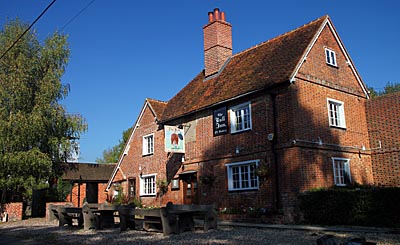 |
 |
|||
|
|
 Stanford Dingley Stanford DingleyFounders & Family Heiresses Stanford was the 'stony ford' across the River Pang. This was usually a Saxon name applied to a Roman crossing, but there are no known Roman roads in the area. Perhaps it was a smaller track. The place is, of course, listed in the Domesday Survey of 1086. There were eleven serfs & villeins (tenant farmers) and two bordars (cottage dwellers) and their families, and even a mill. Today, the village is full of 17th and 18th century houses. Notable are the two pubs. The Boot Inn is famous, these days, as the former local of the Duchess of Cambridge. The Bull is more historically interesting. It is an old coaching inn dating back to the 15th century where you can still partake of the ancient game of 'Ring the Bull'. You must hook a horn using a ring suspended from the ceiling. Stanford Dingley Church, like its namesake in the Vale, is dedicated to St. Denys, the headless Parisian martyr. He can be seen on the lectern holding his decapitated head in his hands. The west end of the nave and sides of the chancel arch are thought to contain Saxon work. In the 13th century the church interior was a blaze of colour with many fine wall paintings to help the vicar explain the gospels to the country folk. They were whitewashed out at the Reformation, but were rediscovered by the Victorians. Unfortunately, some of the pictures offended their sensibilities and they quickly covered them up again. St. Christopher has gone, but you can still see St. Edmund the Martyr and St. Thomas Becket. Hidden beneath the carpet in the
north aisle is the brass memorial to Margaret (died 1444), the wife of
William Dingley. This reminds
us of the family who gave the village its suffix. They originally came
from Dineley near Burnley, in Lancashire, but settled in the old manor
house that once stood within the moat round the Manor Farm of 1821. Their other major
property was at Wolverton, near Basingstoke, in Hampshire. William was an Esquire (or bodyguard) to
King Henry VI and the grandson
of the Master of the Royal Buckhounds, Sir
Bernard Brocas Junior. He inherited Stanford Manor from Margaret's father, for she was the daughter
and heiress of Thomas Foxcott of both this village and Foxcott in
Hampshire. Margaret was remarkable in being descended from a large number
of heraldic heiresses on both her father and her mother's side of the
family. Through her descendants, their coats of arms have passed on to
many Berkshire families, most notably the Earls of Radnor from Coleshill
House. Two of these heiresses were from the Chenduit and the FitzHerbert
families who held the manor in earlier years. The FitzHerbert arms survive
on Margaret's brass. They were the Barons FitzReynold in the late 13th and
early 14th century. They held many lands all over the country, including
two castles in Wales, but may have favoured both Stanford and Crookham,
near Newbury, for the first Baron is known to have conducted business with
Edward II in Reading. Crookham was his father's home. Stanford was his
mother's home. She was the heiress of her brother, Oliver de Stanford, who
had lived there until his death in 1260. Across the
centuries, several Stanford farmers have become prominent men, both
locally and nationally. The Lyfords were lords of the manor of Peasemore, but preferred to live at Rushdens Farm in the extreme west of
Stanford parish. John Lyford (died 1589) also did business in London. He
had eighteen children and has another brass memorial in Stanford Dingley Church.
The Tesdale family also lived in the parish during this period. Thomas
Tesdale was born there in 1547 but, soon afterwards, the family
moved to Abingdon. It was in that town
that he made a fortune as a malt merchant. With no children of his own, he
left is money to Oxford University and the powers that be used it to found
Pembroke College. By 1830, mechanization had changed the face of Stanford
farms out of all recognition. The farm workers were not best pleased and
destroyed agricultural machines and fired hay ricks on local farms during the
Berkshire Machine Riots.
|
|||
| © Nash Ford Publishing 2011. All Rights Reserved. | ||||


